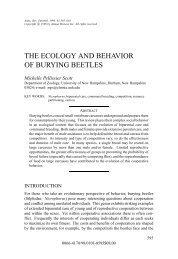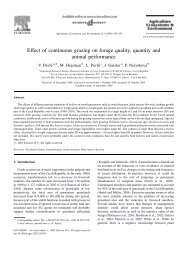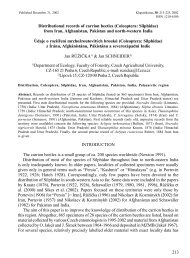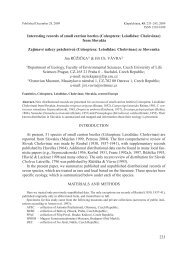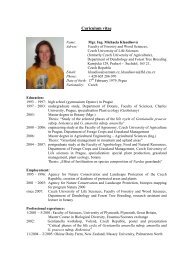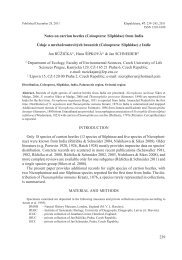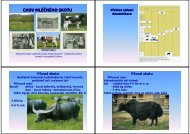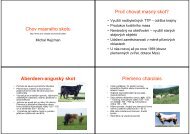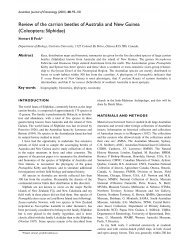<strong>ZOOTAXA</strong>65Schweitzer, D.F. & Master, L.L. (1987) Nicrophorus americanus (American burying beetle): resultsof a global status survey. The Nature Conservancy, Eastern Heritage Task Force, Boston, MA13 pp. (unpublished report: biology, conservation)Scopoli, J.A. (1763) Entomologia Carniolica : exhibens insecta Carnioliae indigena et distributa inordines, genera, species, varietates, methodo Linnaeana / Ioannis Antonii Scopoli. Vindobonae: Typis Ioannis Thomae Trattner, 1763; [xxxvi], 420 p. (checklist)Scott, M.P. (1989) Male parental care and reproductive success in the burying beetle Nicrophorusorbicollis. Journal of Insect Behavior, 2(1), 133-137. (biology, behavior) [Broods that receivedbiparental care were both smaller and had lower offspring weight [possible artifact?]] [!N, S]Scott, M.P. (1990) Brood guarding and the evolution of male parental care in burying beetles.Behavioral Ecology and Sociobiology, 26(1), 31-39. (biology, behavior) [!S]Scott, M.P. (1994a) Competition with flies promotes communal breeding in the burying beetle,Nicrophorus tomentosus. Behavioral Ecology and Sociobiology, 34, 367-373. (biology, ecology,behavior) [On both medium and large carcasses, pairs rearing broods on flyblown carcasseshad fewer young than pairs on clean carcasses or foursomes on flyblown carcasses.][!S]Scott, M.P. (1994b) The benefit of paternal assistance in intra- and interspecific competition for theburying beetle, Nicrophorus defodiens. Ethology Ecology & Evolution, 6(4), 537-543. (biology,behavior) [Paternal care reduces the probability that the carcass will be usurped by a conspecificcompetitor.] [!S]Scott, M.P. (1996) Communal breeding in burying beetles. American Scientist, 84, 376-382. (popularreview) [Review of aspects of communal breeding.] [!S]Scott, M.P. (1997) Reproductive dominance and differential ovicide in the communally breedingburying beetle Nicrophorus tomentosus. Behavioral Ecology and Sociobiology, 40(5), 313-320. (biology, behavior) [Influences of size of beetles and carcasses on communal breeding.]Scott, M.P. (1998a) Facultative adjustment of the duration of parental care by burying beetles. Journalof Insect Behavior, 11(4), 597-603. (biology, behavior) [Males raised in lab in dense groupsprovided longer care than males raised in isolation (cues for detection of population density).][!S]Scott, M.P. (1998b) The ecology and behavior of burying beetles. Annual Review of Entomology,43, 595-618. (biology, review of: ecology, behavior) [Lengthy review of literature on Nicrophorusbehavior.] [!S]Scott, M.P., & Gladstein, D.S. (1993) Calculating males? An empirical and theoretical examinationof the duration of paternal care in burying beetles. Evolutionary Ecology, 7(4), 362-378. (biology,behavior) [Variables: size of carcass & probability of usurpation.] [!S]Scott, M.P. & Traniello, J.F.A. (1987) Behavioural cues trigger ovarian development in the buryingbeetle, Nicrophorus tomentosus. Journal of Insect Physiology, 33(10), 693-696. (biology,behavior, physiology)Scott, M.P. & Traniello, J.F.A. (1989) Guardians of the Underworld. Natural History, 6, 32-36.(popular review) [!S]Scott, M.P. & Traniello, J.F.A. (1990) Behavioural and ecological correlates of male and femaleparental care and reproductive success in burying beetles (Nicrophorus spp.). Animal Behaviour,39(2), 274-283. (biology, ecology, behavior) [!S]Scott, M.P., Traniello, J.F.A., & Fetherston, I.A. (1988) [“1987”] Competition for prey between antsand burying beetles (Nicrophorus spp.): Differences between northern and southern temperatesites. Psyche (Cambridge, Massachusetts), 94(3-4), 325-331. (biology, ecology) [Southernsites had more intense competition with ants.] [!S]Scott, M.P., Trumbo, S.T., Neese, P.A., Bailey, W.D., & Roe, M.R. (2001) Changes in biosynthesisand degradation of juvenile hormone during breeding by burying beetles: a reproductive orsocial role? Journal of Insect Physiology, 47(3), 295-302. (biology, behavior, physiology)288 © 2002 Magnolia PressSIKES ET AL.
[Suggests role of increase in JH upon carcass discovery is not to influence vitellogenesis but toinfluence behavior.] [!S]Scott, M.P., & Williams, S.M. (1993) Comparative reproductive success of communally breedingburying beetles as assessed by PCR with randomly amplified polymorphic DNA. Proceedingsof the National Academy of Sciences, USA, 90(6), 2242-2245. (biology, behavior) [“The maleand female providing longer care, usually the larger of each sex, were the mother and father ofmost larvae (50-100%).”]Scriba, W. (1864) Ueber Necrophorus fossor und gallicus. Berliner Entomologische Zeitschrift, 8,377-378. (descriptions in German)Scriba, H. v. L.G. (1790) [“1790-1791”] Neuestes Magazin für die Liebhaber der Entomologie.(Frankfurt, bey Varrentrapp und Wenner, 1790-[1791]), 1, 1-296. (in German) [not found]Seidlitz, G. (1874) Fauna Baltica. Die Käfer (Coleoptera) der Ostseeprovinzen Russlands [3. Lieferung].H. Laakmann, Dorpat. pp. 49-80 (Gattungen), 209-340 (Arten). pp. 1872. (key in German)[!N]Seidlitz, G. (1888) Fauna Baltica. Die Kaefer (Coleoptera) der Deutschen Ostseeprovinzen Russlands.Zweite neu bearbeitete Auflage. [Lieferung 2, 3: Gattungen, pp. 17-80, Arten, pp. 97-336]. Hartungsche Verlagsdruckerei, Königsberg. pp. 1891. (key in German) [!N]Seidlitz, G. (1889) Fauna Transsylvanica. Die Kaefer (Coleoptera) Siebenbürgens. [Lieferung 3-4:Gattungen, pp. 49-128, Arten, pp. 241-544]. Hartungsche Verlagsdruckerei, Königsberg. pp.1891. (key in German) [!N]Selous, C.F. (1911) A preliminary note on the so-called carrion-feeding Coleoptera. Entomologist'sMonthly Magazine, 47, 86-89. (biology) [“Beetles flew into wind, walking last few feet to carrion,dragged carcasses to softer earth. Not convinced that Nicrophorus are feeders on carrion,probably predators.”-Milne & Milne 1944.]Semenov-Tian-Shanskij, A. (1894) Coleoptera Asiatica nova. Horae Societatis EntomologicaeRossicae, 28, 526-547. (description in Latin) [Original description of N. przewalskii.] [!S]Semenov-Tian-Shanskij, A. (1926) Analecta coleopterologica, XIX. Russkoye EntomologicheskoeObozrenie, 20, 33-55. (descriptions in Latin) [Original description of Necroxenus (=Nicrophorus).][!N]Semenov-Tian-Shanskij, A. (1933) De tribu Necrophorini (Coleoptera, Silphidae) classificanda etde ejus distributione geographica. Trudy Zoologicheskogo Instituta Akademii Nauk SSSR, 1,149-160. (catalog in Russian & Latin) [Original description of 8 genus-group names, all=Nicrophorus: Eunecrophorus, type species=N. americanus; Necrophoriscus, type species=N.lunatus; Nesonecrophorus, type species=N. podagricus; Necrocphorindus, type species=N.validus; Necroleptes, type species=N. humator; Nesonecropter, type species=N. distinctus;Necropter, type species=N. investigator; Stictonecropter, type species=N. pustulatus.] [!N,S]Seok, D.M. (1970) The insect fauna of the Is. Querpart. Bojinjae, Seoul, 186 pp. (checklist)Sharp, D. (1907) The proceedings of the Entomological Societ of London for the year 1907: Micromorphismin Coleoptera. The Transactions of the Entomological Society of London, pp. i-clxv.(morphology: micromorphism)Sharp, D. & Muir, F. (1912) The comparative anatomy of the male genital tube in Coleoptera.Transactions of the Entomological Society of London, 1912, 477-642. (morphology: male genitalia)[!N, S]Sharps, J.C. (1994) American burying beetle (Nicrophorus americanus) and western prairie fringedorchid (Platanthera praeclara) survey in Minnehaha County, SD, project P 6146 (l) & (2)PCEMS 357th and 3805. Final report to the South Dakota Department of Transportation,Pierre, SD. (unpublished report: biology, conservation)Shchegoleva-Barovskaya, T.I. (1933a) Les Necrophorini (Coleoptera, Silphidae) de la faune del'URSS (avec 11 fig.). Trudy Zoologicheskogo Instituta Akademii Nauk SSSR, 1, 161-191.<strong>ZOOTAXA</strong>65CATALOG OF NICROPHORINAE© 2002 Magnolia Press 289
- Page 7 and 8:
HistoryLinnaeus named two species o
- Page 10 and 11:
ZOOTAXA65nomina nuda, misspellings,
- Page 12 and 13:
ZOOTAXA65AcknowledgementsThis proje
- Page 14 and 15:
ZOOTAXA65Available species group na
- Page 18 and 19:
ZOOTAXA peruvianus Pic, 1917; as va
- Page 20 and 21:
ZOOTAXA plagiatipennis Lewis, 1879;
- Page 22 and 23:
ZOOTAXA 1790 Olivier: no. 10, p. 6
- Page 24 and 25:
ZOOTAXA 1989 Kozol: 1-10 (biology,
- Page 26 and 27:
ZOOTAXA 1868 Gemminger & Harold: 71
- Page 28 and 29:
ZOOTAXA 1970 Franz: 213 (checklist,
- Page 30 and 31:
ZOOTAXA 1933 Semenov-Tian-Shanskij:
- Page 32 and 33:
ZOOTAXA 1895b Reitter: 326 (descrip
- Page 34 and 35:
ZOOTAXA 1986 Anderson & Peck: 283 (
- Page 36 and 37:
ZOOTAXA65Florida. The melanic popul
- Page 38 and 39:
ZOOTAXA 1986 Cho & Lee: 20 (phyloge
- Page 40 and 41:
ZOOTAXA65N. confusus and N. sepulto
- Page 42 and 43:
ZOOTAXA 1884 Marseul: 185 (key, des
- Page 44 and 45:
ZOOTAXA 1990 Peck: 1123 (key)651990
- Page 46 and 47:
ZOOTAXA 1870 Motschulsky: 352 (desc
- Page 48 and 49:
ZOOTAXA = flexuosus Portevin,192465
- Page 50 and 51:
ZOOTAXA 1761 Sulzer: pl. 2, fig. 10
- Page 52 and 53:
ZOOTAXA 1889 Fowler: 43 (descriptio
- Page 54 and 55:
ZOOTAXA 1983 Putman: 38-42 (biology
- Page 56 and 57:
ZOOTAXA 2002 Nikolajev & Kozminykh:
- Page 58 and 59:
ZOOTAXA 1895b Reitter: 324 (descrip
- Page 60 and 61:
ZOOTAXA 1884 Marseul: 184 (key, des
- Page 62 and 63:
ZOOTAXA 1930 Roubal: 240 (catalog i
- Page 64 and 65:
ZOOTAXA 1910 Barkowski: 80 (key, de
- Page 66 and 67:
ZOOTAXA 1928 Hatch: 130 (catalog)65
- Page 68 and 69:
ZOOTAXA 1870 Vollenhoven et al.: 54
- Page 70 and 71:
ZOOTAXA 1939 Lengerken: 263 (biolog
- Page 72 and 73:
ZOOTAXA 1986 Nishikawa: 99 (catalog
- Page 74 and 75:
ZOOTAXA 1909 Bickhardt: 75 (descrip
- Page 76 and 77:
ZOOTAXA Nicrophorus hybridus Hatch
- Page 78 and 79:
ZOOTAXA65“PARALECTOTYPE Nicrophor
- Page 80 and 81:
ZOOTAXA 1944 Arnett: 7 (morphology:
- Page 82 and 83:
ZOOTAXA 1882 Gradl: 331 (descriptio
- Page 84 and 85:
ZOOTAXA 1993b Kozminykh: 65 (key, d
- Page 86 and 87:
ZOOTAXA 1965b Roussel: 6452 (morpho
- Page 88 and 89:
ZOOTAXA 1926a Portevin: 257 (revisi
- Page 90 and 91:
ZOOTAXA = pasqueti Pic, 1917 NEW ST
- Page 92 and 93:
ZOOTAXA65Lectotype data for Nicroph
- Page 94 and 95:
ZOOTAXA 1891 Heyden et al.: 138 (ch
- Page 96 and 97:
ZOOTAXA 1971 Freude: 194 (key in Ge
- Page 98 and 99:
ZOOTAXA 1995 Kozminykh: 110 (key in
- Page 100 and 101:
ZOOTAXA65Type depository: MCZC: Cam
- Page 102 and 103:
ZOOTAXA 1868 Gemminger & Harold: 71
- Page 104 and 105:
ZOOTAXA 1925 Winkler: 264 (catalog)
- Page 106 and 107:
ZOOTAXA65Type depository: MZHF: Hel
- Page 108 and 109:
ZOOTAXA 1866 Marseul: 38 (catalog i
- Page 110 and 111:
ZOOTAXA 1926a Portevin: 222 (revisi
- Page 112 and 113:
ZOOTAXA 1866 Michow: 411 (descripti
- Page 114 and 115:
ZOOTAXA 1899 Ganglbauer: 164 (descr
- Page 116 and 117:
ZOOTAXA65from reduced to absent, bu
- Page 118 and 119:
ZOOTAXA Paralectotype data “17/67
- Page 120 and 121:
ZOOTAXA Nicrophorus maculifrons Kra
- Page 122 and 123:
ZOOTAXA 1955b Nakane: 54 (key, desc
- Page 124 and 125:
ZOOTAXA 1911 Wickham: 10 (checklist
- Page 126 and 127:
ZOOTAXA 2000 Sikes & Peck: 395 (des
- Page 128 and 129:
ZOOTAXA65with the elytral fascia sh
- Page 130 and 131:
ZOOTAXA 1975a Emetz: 60 (checklist
- Page 132 and 133:
ZOOTAXA65border “LECTOTYPE Nicrop
- Page 134 and 135:
ZOOTAXA 1992 Kozminykh: 64 (checkli
- Page 136 and 137:
ZOOTAXA 1879 Dohrn: 459 (comment in
- Page 138 and 139:
ZOOTAXA Nicrophorus nigricornis Fal
- Page 140 and 141:
ZOOTAXA 1920 Leng: 86 (catalog) >>
- Page 142 and 143:
ZOOTAXA 1925 Winkler: 264 (catalog)
- Page 144 and 145:
ZOOTAXA65Type depository: BMNH: Lon
- Page 146 and 147:
ZOOTAXA 1933 Wolcott & Montgomery:
- Page 148 and 149:
ZOOTAXA 1994 Beninger: 135-143 (bio
- Page 150 and 151:
ZOOTAXA Nicrophorus podagricus Port
- Page 152 and 153:
ZOOTAXA 1999 Háva et al.: 76 (key,
- Page 154 and 155:
ZOOTAXA 1982c Anderson: 1316 (biolo
- Page 156 and 157:
ZOOTAXA Nicrophorus quadraticollis
- Page 158 and 159:
ZOOTAXA 1933 Semenov-Tian-Shanskij:
- Page 160 and 161:
ZOOTAXA 1994a Ôhara: 58 (checklist
- Page 162 and 163:
ZOOTAXA 1895b Reitter: 324 (descrip
- Page 164 and 165:
ZOOTAXA 1985 Peck & Anderson: 287 (
- Page 166 and 167:
ZOOTAXA Nicrophorus scrutator Blanc
- Page 168 and 169:
ZOOTAXA 1859 Schaum: 36 (catalog in
- Page 170 and 171:
ZOOTAXA 1849 Bach: 153 (checklist,
- Page 172 and 173:
ZOOTAXA 1980 Franssen: 46 (morpholo
- Page 174 and 175:
ZOOTAXA 1887 Lewis: 341 (descriptio
- Page 176 and 177:
ZOOTAXA65139.48°E,]19-24 August 18
- Page 178 and 179:
ZOOTAXA 1970 Gersdorf: 366 (morphol
- Page 180 and 181:
ZOOTAXA 1998b Scott: 598+ (biology,
- Page 182 and 183:
ZOOTAXA 1944 Arnett: 5 (morphology:
- Page 184 and 185:
ZOOTAXA 1761 Rösel von Rosenhof: 2
- Page 186 and 187:
ZOOTAXA 1873 Klika: 127 (checklist
- Page 188 and 189:
ZOOTAXA 1939 Székessy: 943 (morpho
- Page 190 and 191:
ZOOTAXA 1987 Jensen: 116 (biology,
- Page 192 and 193:
ZOOTAXA 1881 Westhoff: 108 (descrip
- Page 194 and 195:
ZOOTAXA65Type depository: LNMD: Mü
- Page 196 and 197:
ZOOTAXA 1888 Seidlitz: 313 (key in
- Page 198 and 199:
ZOOTAXA 1948 Clark: 27 (checklist)6
- Page 200 and 201:
ZOOTAXA 1982 Wisiniewski (biology,
- Page 202 and 203:
ZOOTAXA 1993 RÉÓigka: 34 (checkli
- Page 204 and 205:
ZOOTAXA = aurora Motschulsky, 1860
- Page 206 and 207:
ZOOTAXA 1937 Leech: 156 (nomenclatu
- Page 208 and 209:
ZOOTAXA 1885 Marseul: 169 (catalog
- Page 210 and 211:
ZOOTAXA 1937 Leech: 156 (nomenclatu
- Page 212 and 213:
ZOOTAXA Nicrophorus vestigator Hers
- Page 214 and 215:
ZOOTAXA 1922 Sherborn: 6882 (catalo
- Page 216 and 217:
ZOOTAXA65Spanish)2002 Nikolajev & K
- Page 218 and 219:
ZOOTAXA 1902 Heyden: 12 (nomenclatu
- Page 220 and 221:
ZOOTAXA = olfactor Gistel, 1848 NEW
- Page 222 and 223:
ZOOTAXA PTOMASCOPUS Kraatz, 1876: 3
- Page 224 and 225:
ZOOTAXA65Type depository: BMNH: Lon
- Page 226 and 227:
ZOOTAXA 1925 Winkler: 265 (catalog)
- Page 228 and 229:
ZOOTAXA Ptomascopus zhangla Háva,
- Page 230 and 231:
ZOOTAXA65ReferencesAbbott, C.E. (19
- Page 232 and 233:
ZOOTAXA65nepalensis are more closel
- Page 234 and 235:
ZOOTAXA65Bedick, J.C. (1997) Distri
- Page 236 and 237:
ZOOTAXA65Blanchard, É. (1842) Inse
- Page 238 and 239: ZOOTAXA65description of N. didymus.
- Page 240 and 241: ZOOTAXA65Conley, M.R. (1982) Carrio
- Page 242 and 243: 65ZOOTAXA Delahon, P. (1913) Nachtr
- Page 244 and 245: ZOOTAXA65Eisfelder, I. (1963) Käfe
- Page 246 and 247: ZOOTAXA65Faldermann, F. (1835a) Add
- Page 248 and 249: ZOOTAXA65Gaubil, J. (1849) Catalogu
- Page 250 and 251: ZOOTAXA65Gwiazdowicz, D.J. (2000) M
- Page 252 and 253: ZOOTAXA65Hausmann, J.F.L. (1799) En
- Page 254 and 255: ZOOTAXA65Hlisnikovsky, J. (1942) Co
- Page 256 and 257: ZOOTAXA65Jakovlev, B.E. (1887) Col
- Page 258 and 259: ZOOTAXA65Kirby, W. & Spence, W. (18
- Page 260 and 261: ZOOTAXA65Kozminykh, V.O. (1997) Fau
- Page 262 and 263: ZOOTAXA65Labitte, A. (1916) Longév
- Page 264 and 265: ZOOTAXA65Lindroth, C.H. & Ball, G.E
- Page 266 and 267: 65ZOOTAXA Marseul, S.-A. (1866) Cat
- Page 268 and 269: ZOOTAXA65Miller, S.E. & Miller, P.M
- Page 270 and 271: ZOOTAXA65Müller, J.K. & Dressel, J
- Page 272 and 273: ZOOTAXA65Newman, E. (1838) Entomolo
- Page 274 and 275: ZOOTAXA65Opler, P.A. [ed.] (1985) S
- Page 276 and 277: ZOOTAXA65Peck, S.B. & Miller, S.E.
- Page 278 and 279: ZOOTAXA65Portevin, G. (1914a) Silph
- Page 280 and 281: ZOOTAXA65Ranson, J. (1864) Fecundit
- Page 282 and 283: ZOOTAXA65Riha, P. (1949) Nova odchy
- Page 284 and 285: ZOOTAXA65RÉÓigka, J. (1999) Beetl
- Page 286 and 287: ZOOTAXA65Schneider, P. (1978) Die F
- Page 290 and 291: 65ZOOTAXA (revision: key, descripti
- Page 292 and 293: ZOOTAXA65Smith, R.J., Hines, A., Ri
- Page 294 and 295: ZOOTAXA65Stroud, C.P. (1950) A surv
- Page 296 and 297: ZOOTAXA65Trumbo, S.T. (1990b) Repro
- Page 298 and 299: ZOOTAXA65Walkden, H.H. (1944) Insec
- Page 300 and 301: ZOOTAXA65Xambeu, P. (1892) Moeurs e
- Page 302 and 303: ZOOTAXA65Index (continued)Nicrophor
- Page 304: ZOOTAXA65Index (continued)Nicrophor



